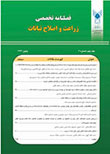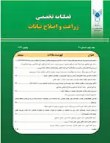فهرست مطالب

فصلنامه زراعت و اصلاح نباتات
سال دهم شماره 4 (زمستان 1393)
- تاریخ انتشار: 1393/12/20
- تعداد عناوین: 10
-
Pages 1-7This research designed to investigate the effects of potassium sulfate and potassium chloride to enhance performance and grain protein content of wheat in soils of Mazandaran. The experiment was conducted in Qrakhyl Ghaemshahr to determine good source and levels of potassium on qualitative and quantitative performance of wheat in 1389. Experiment was performed as factorial in a randomized complete block design. Treatments were different amount of potassium fertilizer (100 and 200 and 300) as K2O kg per hectare and a control treatment. The other treatments were two types of potassium fertilizers (Potassium sulfate، potassium chloride). Initial analysis of the results showed significant differences on grain yield at 1% probability level، but the other factors have not significant difference between fertilizers sources. Also the highest protein content obtained (9/14) in 300 kg potassium chloride per hectare.Keywords: Potassium Sulphate, Potassium Chloride, Wheat
-
Pages 9-19Bean (Paseolus vulgaris L.) with 22% proteins has a significant role to provide required proteins of human and also storage protein are used as molecular marker in genetic diversity evaluation for different species. In this study، 84 accession of P. Vulgaris collection from National plant gene bank of Iran which originated from 24 different provinces of Iran are considered by means genetic diversity، genetic structure and genetic distance between population of agriculture type and origin provinces. SDS-PAGE unidimentional electrophoresis is used to study genetic diversity of seed storage proteins. Among of considered accessions 32 alleles were detected which 76 % were polymorphic. The average of real alleles was 1/84 and the average of effective allele was 1/35. The average of genetic diversity was 22%. The comparison of population shows a high level of similarity in diversity and shanon index (I=23% h=22%). cluster analysis using UPGMA method divided agriculture types of، red، white and cheeti in two groups. Agronomic types show different in color and similarity in storage proteins diversity that probably in long evaluation had similarity progenitors and provinces population clustered in three groups. Keywords:Keywords: Bean, genetic diversity, storage protein, electrophoresis SDS, PAGE
-
Pages 21-29In order to study the effect of animal manure، biofertilizer and different level of phosphorus manure on yield and grain yield components of barley under dryland condition an experiment was conducted in field of Saleh-Abad region of Ilam Province in 2013-2014. The experiment design were carried out in split split plot based on a randomized complete block design (RCBD) with three replications، that animal manure include: use and non-use in main plots، Phosphorus chemical fertilizer at four levels including: non-use، use based on 33، 66 and 100 % of the plant need in sub-plots and Barvar-2 biofertilizer at two levels including: application and non- application were in sub sub-plots. In this study، grain yield، number of spike per m2، number of grain per spike and 1000-grain weight were tested and measured. Results of analysis of variance showed that all of traits affected by experimental factors. The results of the experiment، use a single bio-fertilizer Barvar-2 and animal manure had higher grain yield than non-use treatment of them. Experiment results also showed that the highest yield of barley with 3179/4 kg/ha related to treated of simultaneous use of biofertilizer، animal manure and phosphorus fertilizer 66 % of the plant need، and the lowest grain yield belonged to non-use biofertilizer، animal manure and chemical phosphorus fertilizer (control treatment) combination treatment.Keywords: Dryland barley, Biofertilizer, Animal manure, Phosphorus fertilizer, Grain yield.
-
Pages 31-41This experiment was conducted to investigate the effects of plant density and nitrogen management on yield and quality of durum wheat promising lines of D-81-6 in temparate climates. The experimental design was RCBD in split factorial arrangement with two factors and three replicates. The factors studied were seed density in main-plots including 400، 500 and 600 seeds/m2 for the temperate climates of Karaj and nitrogen management in sub-plots including 10 levels of nitrogen rates (138 or 184 Kg/ha N) and timings of control (no N application) and one third split soil application of nitrogen fertilizer as basal or top dressed in each growth stages of complete tillering، mid-jointing or anthesis onset. According to the simple and combined ANOVA results in Karaj there was no significant effect of seed density on grain yield and other studied parameters and the recommended density was 400 seeds/m2 but nitrogen had very significant effect on the grain yield and other studied parameters and the recommended N usage was 138 Kg/ha N and the one third basal and split top-dressed application in any stages of complete tillering، mid-jointing or anthesis onset. But concluding remark was to use nitrogen according to the cropping history and the soil N test results.Keywords: Durum wheat, Seed Density, Nitrogen Management
-
Pages 43-55The relationships of some wheat traits and theirs direct and indirect influence on the grain yield (GY) were investigated. In base of important of subject this research conducted in form of factorial in based on random complete blocks design with four replication in research field farm of Islamic Azad University of Karaj branch in 2010-2011. Experimental treatments including: Low irrigation in three levels (Normal irrigation (NI)، Non irrigation from stem elongation to anthesis (NI1)، Non irrigation from anthesis to maturity (NI2)) and phosphorous spraying in four density: 0، 4، 6، 8 kg/ha from source of Potassium de-hydrogen Phosphate (KH2PO4). According to results observed significant correlation (α = 0. 01) between GY and Biomass (TDW)، 1000 grain weight (TGW)، and harvest index (HI). In stepwise regression method under NI condition، some traits including Biomass &harvest index and under NI1 condition، grain number per ear (GNE)، ear number per m2 (EN)، plant height (PH) & unit grain weight (UGW) and under NI2 condition some traits including biomass (TDW)، harvest index (HI)، 1000 grain weight (TGW) & fertile spikelet number (NFS) remained in final model R2 was equal to 0. 97، 0/99 and 0. 997، respectively. Path analysis results showed that the biomass has a highest direct and positive effect under normal irrigation (1. 511) and NI2 condition (0. 828)، on GY، but in NI1 condition، highest direct and positive effect related to grain number per ear (GNE) trait (1/231). Among the Other traits، grain number per ear (0/849) trait، has a highest indirect effect on GY. Totally designated increasing of Biomass and grain number per ear traits are important way for increasing of GY trait.Keywords: Path analysis, Correlation, Wheat, Drought stress
-
Pages 57-67To study of resistance to sunn pest (Eurygaster integriceps) in bread wheat، parents including Falat (Resistant) × sardari (Susceptible) were crossed and generations of F1، F2، BC1 and BC2 were obtained. The six basic generations (parent، first and second filial generations (F1، F2)، first and second backcrosses (BC1، BC2) of crossings were planted in a Randomized Complete Block design with three replications at the Research Farm of Islamic Azad University، Karaj، Iran. Analysis of weighted variance showed that differences between generations were significant for all traits، except for total seed weight in damaged spikes. Joint scaling test showed that both additive and dominance componenets were involved and at the most time epistasis was implicated. In spite of this the additive components were most important. In seed-damaged percentage، as the most important trait، m، d، h، I and l model was significant.Keywords: Sunn pest, Generation mean analysis, Gene action, Resistance
-
Pages 69-79Wheat is usually injured by sunn pest (Eurygaster integriceps) and this damage is important for farmers and bakers. The sunn pest is very serious in IRAN. Using of resistant varieties in integrated management program is one of the suitable methods. In order to map the Quantitative Trait Loci (QTLs) for sunn pest resistance in bread wheat and to determine the contribution of each QTL in phenotypic variations، a F2:3 derived population from crossing between cv. FALAT (resistant) and line 12 (susceptible) were evaluated. The traits under study included: weight of five damaged spikes، weight of damaged seed in damaged spikes، weight of fifty damaged seeds and damaged seed percent. The linkage map was constructed using 35 SSR and 68 AFLP markers. The markers were assigned to 27 linkage groups using linkage analysis. Total map length was 875. 6 cM with an average interval size of 12. 9 cM. For damaged seed percent، as important trait، four QTLs were identified which explained 44% of the phenotypic variations. According to these results one can hope to identify the related traits with resistance using molecular markers and QTL analysis.Keywords: Sunn pest, QTL analysis, SSR, AFLP
-
Pages 81-88Drought is one the most important factors limiting yield and culture area of crop plants which also may modify the yield quality. Identification of genetic factors improving plant drought tolerance might increase the efficiency of breeding programs aimed to attain drought tolerant cultivars. In order to find genomic regions affecting drought tolerance، as well as markers linked to drought tolerance، 100 recombinant inbred lines including their two parents، RHA266 and PAC2، were cultured in field under full and limited irrigation as an alpha-lattice arrangement with two replications. Analysis of variance revealed significant differences among the genotypes in both conditions. QTL mapping using composite interval method resulted in identification of several genomic regions controlling the drought tolerance traits. Some yield QTLs were common in both normal and drought conditions، and some were specific to drought condition. Results suggested that selecting for lines with heavier seeds would result in superior genotypes for drought condition. Markers linked to the studied traits were identified.Keywords: Sunflower, Recombinant inbred lines, QTL mapping, drought stress, genomic regions
-
Pages 91-103To consider the relationship between allelic diversity of sixteen microsatellite markers of major QTL controlling drought tolerance on chromosome number 2 of rice and some of phenotypic traits in some types of Iranian and experimental imported rice was performed in two molecular and phenotypic parts in Plant breeding laboratory of Gonbad-e-Kavoos university at 2012. Studied characteristics included the root dimension, root weight, root amounts, stem weight, stem length, root length, genotypic code and biomass. Variance analysis of studied characteristics indicated that there is a very significant difference between genotypes of studied characteristics under the drought conditions. In this study 49 allele was observed that the most amount of allele is related to RM3302 marker with 6 alleles and the most gene variety and the highest PIC were related to RM8030. Stepwise regression analysis was used for relationship between phenotypic traits as dependent variable and alleles as independent variable and showed that 17 alleles have significant association with at least one of the eight phenotypic traits under drought condition that can be profit in breeding with marker assisted selection and produce tolerant variety in the seedling stage in drought stress.Keywords: Allelic diversity, Drought stress, Rice
-
Pages 105-113The interaction between genotype and environment is reason that researchers evaluate new cultivars in wide range of environmental conditions. These information is very useful in determine of cultivar stability and regional adaptability. In order to evaluate stability of open pollination sunflower cultivars for oil percent، an experiment on 10 open pollinated sunflower varieties in five agricultural research centers: Karaj، Urmia، Bojnourd، Shiraz and Islamabad in a randomized complete block design with four replications were done. The interaction of genotype and environment investigated with AMMI method. Three interaction principal components explain over 95 percent of the total variance. In the AMMI1 biplot graph the cultivars: Master، Bulg5، Bulg3 and Islamabad and Bojnourd environments were high in IPCA1 factor and show the greatest influence on interaction effect. Berezans، Favorit، Lakumba، Record and Zaria cultivars and Karaj، Shiraz with Urmia environments have the low IPCA1 and high stability. Base oil performance and stability، Zaria cultivar was the best cultivar. In the AMMI2 biplot graph، Lakumka and Zaria had the least interaction with high common adaptability. Base this graph bulg3 cultivar in Islamabad، Berezans in Karaj and Shiraz، bulg5 in Bojnourd and Favorit and Record in Urmia had the specific adaptability.Keywords: Sunflower_Genotype × Environment Interaction_Adaptability_AMMI


